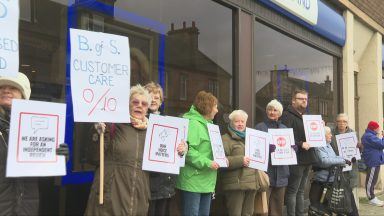Do we care how much of the food we buy comes from Scotland?
According to the National Farmers Union for Scotland we do.
Their figures suggest more than 70% of people would prefer to buy Scottish produce and would pay more to do so.
But they say that demand isn’t being met by supermarkets.
Over the past year the union has been monitoring how many products are labelled as Scottish, and British at 8 major retailers as part of it’s Shelf Watch campaign in a bid to increase local food in our retailers and get a better deal for local producers.
Andrew Connon, the union’s president, said: “We were disappointed initially that only 17% of all brands looked at had Scottish branding on it
“But there’s a big difference between retailers, in how much they stock, Aldi was the clear front runner followed by Lidl’s but others did show an improvement over the year.
“If we could increase this average by another 12% that would equate to £500m more for Scottish producers and the wider farming supply chain.“
Shelf Watch has been one of the union’s largest surveys to date and looked at more than 15 000 own brand products at more than 290 stores across Scotland.
The products most often labelled as from Scottish farms?
Eggs, beef and milk.
It found produce like pork cheese, butter and yoghurt whilst often British, were the least likely items to be from local suppliers.
Farming leaders now want to see an increase in Scottish grown produce also for clearer labelling for consumers.
Andrew added: “We need to see proper source of origin, it’s often difficult for consumers to see if something is imported that needs to change.”
The Scottish Retail Consortium said supermarkets are one of the biggest advocates of clear product labelling, adding: “This report clearly demonstrates the depth of support from the retail industry for Scotland’s farmers despite the enormous economic and public pressures on the industry.
“Of course, different grocers will take bespoke approaches to the profile of products they source.
“Nonetheless, the strength of the hyper-competitive grocery market is consumers can choose whether to purchase Scottish or products from further afield; and retailers will respond to that commercial onus.”
Today’s figures also sparked debate on how much farmers get for their products, some argue that the percentage return is simply too low.
Mike Davis is an arable farmer in Aberdeenshire and said the price wouldn’t have to go up much to help give growers a better deal.
He explained: “I produce milling oats for oatmeal or porridge, the return is 0.6 pence on a 30-gram bowl, and it costs £175 to grow a tonne of oats.
“Basically, it means I make no money, we break even but there’s no profit and you can’t do that long term.
“If we increased the return, it by even 50% which sounds like a huge margin that’s only 0.03 pence, so that would put up the price up by just over a penny.
“Realistically, I don’t think that’s unachievable for a Scottish produced product, 1p more isn’t that much of a difference that’s produced to a high standard locally.”
The debate on food prices and local food production is due to continue at Westminster in June as part of the Food Supply Chain Fairness Bill.
In Scotland, ministers here said: “We have committed £10 million funding over 2023–2025 to support delivery of Scotland’s food and drink strategy, ‘Sustaining Scotland, Supplying the World’.
“This funding facilitates a range of activities and direct engagement with grocery retailers to help increase the volume of Scottish food and drink on retail shelves, including own brand products.”
Both of these programmes have been welcomed by farmers, who say they’ll continue to lobby for a fairer deal.
Follow STV News on WhatsApp
Scan the QR code on your mobile device for all the latest news from around the country





























